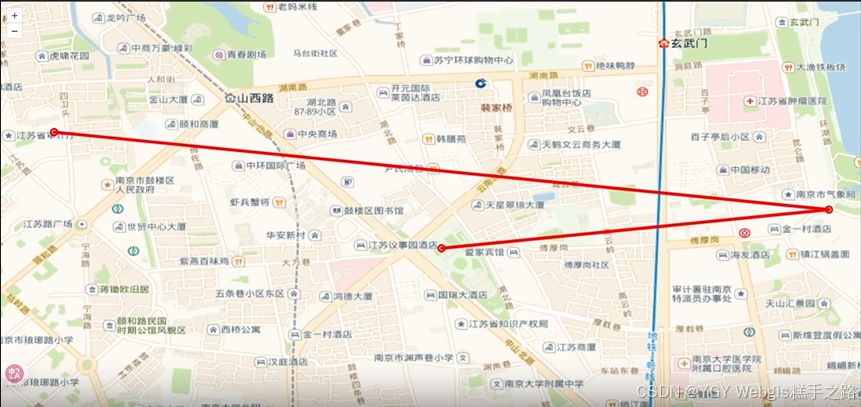OpenLayers 综合案例-动态闪烁
看过的知识不等于学会。唯有用心总结、系统记录,并通过温故知新反复实践,才能真正掌握一二
作为一名摸爬滚打三年的前端开发,开源社区给了我饭碗,我也将所学的知识体系回馈给大家,助你少走弯路!
OpenLayers、Leaflet 快速入门 ,每周保持更新 2 个案例
Cesium 快速入门,每周保持更新 4 个案例
OpenLayers 综合案例-动态闪烁
Vue 3 + OpenLayers 实现的 WebGIS 应用提供了完整的动态闪烁功能
主要功能
- 通过postrender事件监听实现点位半径渐变和线段透明度变化的动画效果,使用getVectorContext获取绘制上下文。
- 采用高德地图底图,支持自定义动画参数

MP4效果动画链接地址
技术栈
该环境下代码即拿即用
Vue 3.5.13+
OpenLayers 10.5.0+
Vite 6.3.5+
<template><div ref="mapContainer" id="map"></div>
</template><script setup>
import { ref, onMounted } from "vue";
import Map from "ol/Map.js";
import XYZ from "ol/source/XYZ.js";
import TileLayer from "ol/layer/Tile.js";
import VectorLayer from "ol/layer/Vector.js";
import VectorSource from "ol/source/Vector.js";
import Feature from "ol/Feature.js";
import Point from "ol/geom/Point.js";
import LineString from "ol/geom/LineString.js";
import { Style, Circle, Stroke } from "ol/style.js";
import { getVectorContext } from "ol/render.js"; // 获取用于在事件画布上绘制的矢量上下文
import View from "ol/View.js";
import "ol/ol.css";const mapContainer = ref(null);
let map = null;
let pointLayer = null;
let lineLayer = null;
let pointFeatures = [];
let lineFeatures = [];// 动画参数
let pointRadius = 0;
let lineOpacity = 1;
let lineDirection = -1;onMounted(() => {// 初始化地图map = new Map({target: mapContainer.value,layers: [new TileLayer({source: new XYZ({url: "https://webrd04.is.autonavi.com/appmaptile?lang=zh_cn&size=1&scale=1&style=7&x={x}&y={y}&z={z}",}),}),],view: new View({center: [118.7784, 32.0647],zoom: 16,projection: "EPSG:4326",}),});// 创建点位要素const point1 = new Feature({ geometry: new Point([118.7784, 32.0647]) });const point2 = new Feature({ geometry: new Point([118.7884, 32.0657]) });const point3 = new Feature({ geometry: new Point([118.7684, 32.0677]) });pointFeatures = [point1, point2, point3];// 创建线段要素const line1 = new Feature({geometry: new LineString([[118.7784, 32.0647],[118.7884, 32.0657],]),});const line2 = new Feature({geometry: new LineString([[118.7884, 32.0657],[118.7684, 32.0677],]),});lineFeatures = [line1, line2];// 创建点位图层pointLayer = new VectorLayer({source: new VectorSource({ features: pointFeatures }),style: new Style({image: new Circle({radius: 5,stroke: new Stroke({ color: "#ff0000", width: 2 }),}),}),});// 创建线段图层lineLayer = new VectorLayer({source: new VectorSource({ features: lineFeatures }),style: new Style({stroke: new Stroke({ color: "#ff0000", width: 3 }),}),});map.addLayer(pointLayer);map.addLayer(lineLayer);// 点位闪烁动画pointLayer.on("postrender", (evt) => {if (pointRadius >= 20) pointRadius = 0;const opacity = (20 - pointRadius) * (1 / 20);const pointStyle = new Style({image: new Circle({radius: pointRadius,stroke: new Stroke({color: `rgba(255,0,0,${opacity})`,width: 3 - pointRadius / 10,}),}),});const vectorContext = getVectorContext(evt);vectorContext.setStyle(pointStyle);pointFeatures.forEach((feature) => {vectorContext.drawGeometry(feature.getGeometry());});pointRadius += 0.3;map.render();});// 线段闪烁动画lineLayer.on("postrender", (evt) => {if (lineOpacity <= 0.2) lineDirection = 1;if (lineOpacity >= 1) lineDirection = -1;lineOpacity += lineDirection * 0.05;const lineStyle = new Style({stroke: new Stroke({color: `rgba(255,0,0,${lineOpacity})`,width: 5,}),});const vectorContext = getVectorContext(evt);vectorContext.setStyle(lineStyle);lineFeatures.forEach((feature) => {vectorContext.drawGeometry(feature.getGeometry());});map.render();});
});
</script><style scoped>
#map {width: 100vw;height: 100vh;
}
</style>
